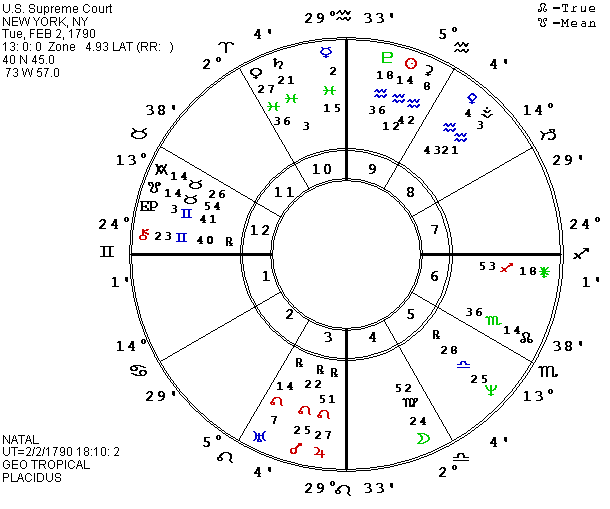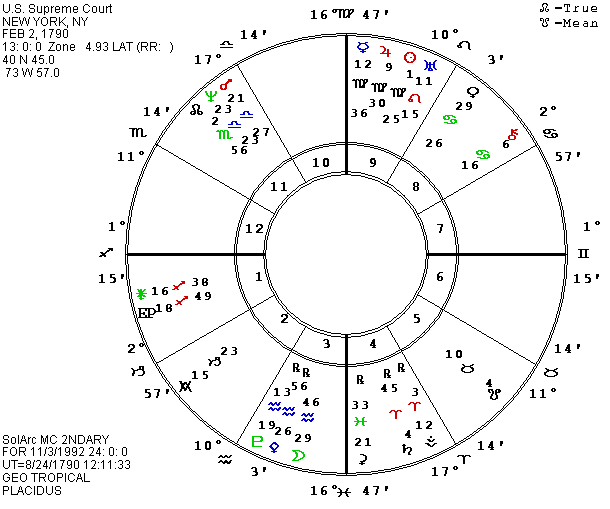The U.S. Supreme Court
Zip Dobyns
In a previous publication, I mentioned that I had learned at the big UAC conference last Easter that there was a historic record of the first meeting of our Supreme Court. As you know, the beginning of anything gives us a horoscope which theoretically describes the entity (person, animal, institution, idea or whatever). A variety of techniques can then be used to describe the development of the entity through time. We have a firm chart for our U.S. Constitution but much controversy over the time of the Declaration of Independence and the inauguration of George Washington, our first President. The inauguration was scheduled for noon, but Washington was very late in arriving and no one seems to know how late. The Supreme Court is an important third branch of our government in addition to the Congress and the President. Its members are appointed by the President, subject to approval by Congress, and they serve for life.
I want to express my thanks to Susan Manuel who sent me the information from a variety of historical sources including the minutes of the first session which was scheduled for February 1, 1790 in New York but which immediately adjourned for lack of a quorum. Additional information comes from the Gazette of the United States, February 3, 1790, No. LXXXV, and from a New York letter dated February 4 in the Pennsylvania Journal and Weekly Advertiser for February 10, 1790. All sources agree that the Court’s first meeting at which business was conducted was held at 1 P.M. on February 2, 1790, in New York City at the Royal Exchange. Local apparent time (LAT) would have been in effect on that date. Local mean time did not come into use until years later in the 19th century.

In astrology, Jupiter, Sagittarius and the ninth house are associated with the judiciary. They symbolize our search for “truth,” our beliefs about what is true and real and morally right, and our judgments which are based on our beliefs and value hierarchy. The chart for the first meeting of the U.S. Supreme Court could not be more appropriate with Jupiter on one angle and Chiron, another Jupiter, on another angle. Jupiter is on the midpoint of the IC in New York and the IC in Washington, DC where the court moved when our capital relocated. Jupiter is within two degrees of both the natal and the local angle and the conjunction with the midpoint is within 5 minutes of longitude. Chiron is on the Ascendant within one degree. Mercury, Jupiter’s partner as traditional keys to mental activity, is more widely conjunct the MC.
The chart’s primary emphasis is clearly on the mind. Mutable signs and houses plus Aquarius are very strong, combined with a major focus in fixed signs which form a wide grand cross in fixed signs but mutable houses. The court’s role is to weigh and evaluate laws and decisions by other, subordinate courts against the touchstone of the Constitution. The court has the final decision, and can override the Executive or the Congress. So its work is mental, especially Jupiterian, but it also has immense power which is associated with the fixed signs. Neptune is the only planet in a cardinal sign and only four of the 19 factors which I use regularly are in cardinal houses. I associate the fixed-mutable emphasis with a relatively stable life accompanying a very active mind.
There are many harmonious aspects including a grand trine in air signs involving Ascendant-Chiron, Neptune, and the MC. Jupiter is conjunct Mars with both of them sextile Neptune and the Ascendant-Chiron. Mars is very strong in the local (Washington) chart where it is conjunct the IC within one degree. The East Point in early Gemini is sextile Uranus in Leo and trine Vesta-Pallas-Ceres in Aquarius and the Sun/Moon midpoint is on the West Point. The air-fire combinations, especially with the emphasis on Aquarius, show the capacity for original, creative, non-conventional ideas, and we have periodically had liberal justices who stretched the meanings of the Constitution. But the chart also has Mercury, Saturn and Venus in Pisces in the tenth house and the Moon in Virgo in the fourth house fitting the times when the court has been very conservative. As a general principle, law tends to be conservative, emphasizing precedent.
The fixed dilemma in mutable houses features a conjunction between Sun and Pluto in Aquarius (equivalent to a fixed T-square since the Sun equates with Leo and Pluto with Scorpio) and they square the lunar nodes and the Vertex axis in Taurus-Scorpio. The mutable houses are the sixth (Virgo) house which calls for practical decisions and the ninth and twelfth houses which seek ideals, the ninth more consciously. The combination fits a focus on material possessions, pleasure and power (Taurus-Scorpio) where there is a need to balance personal possessions etc. with shared possessions. Squares from Pluto and the Sun (equating with Leo) in Aquarius add power connected to ego (Sun) and equalitarian principles and freedom (Aquarius). As I have written before, there is a potential conflict within letter eleven (Uranus-Aquarius-eleventh house) between freedom and equality. An extreme of one prevents the other. A balance somewhere in the middle, moderation in each, is necessary to resolve any conflict. The mutable houses bring in the ethical issues, the conflict between ideals and what is possible, between truth, kindness and efficiency.

So the Supreme Court has juggled this mixture, pulled between property rights and human rights. P Sun opposed Pluto when Reagan and Bush won in 1980 and initiated the choice of justices who would tilt the court to the right in favor of property over people. Bush won the presidency as the P Sun crossed the IC in the chart set for Washington, DC. During his term, it moved into the natal fourth house and into Virgo. In the spring of 1992, I ran the chart for November 3, this past Election Day and tried to guess whether it showed a possible shift or more of the same. The most dramatic aspects were P Moon on the MC, square the local P Ascendant, and quincunx P Venus. The aspects certainly suggested change, but I wasn’t sure whether that meant that the public was going to affect the court or the court was going to impact the public or both. During this transition period of December 1992-January 1993 as Clinton picks his Cabinet members, P Moon is opposing P Sun and squaring P Ascendant so the court and the public still look tense. Right after the election, P Moon moved into Pisces so we can hope that there might be a small move in the direction of compassion. P Mars is also headed for a conjunction with Neptune which might signal the same. One of the remaining liberal judges has been hanging on despite ill health, hoping for a Democratic President who could replace him with another liberal. That might happen soon after the inauguration as P Moon crosses Mercury and trines the P north lunar node in early 1993. P Venus will move into Leo in the late spring of 1993, so by the end of Clinton’s term, it will square the P nodes and oppose Vesta, forming a full grand fixed cross. P Sun will be nearing the end of a two-year quincunx to P Saturn. P MC will also be near the end of a square to the local Ascendant and P Mercury will have joined the P MC. Both of them will also oppose P Ceres in Pisces in the tenth house. The patterns clearly indicate a power struggle—empathy versus practicality, kids versus power, democracy versus elitism. We will see how it shakes out—how far the Clintons can go in moving the government toward Lincoln’s great goal: a government of, by and for the people.